A commercial green roof is a roof that supports plant life. Normally installed on flat roofs, these green spaces can be used as parks, gardens, farms, or research centers. Green roofs and their design are complex, multi-layered systems that require a lot of maintenance, but they may yield your building and community many benefits.
In this guide, we’ll provide general information about what you need to know if you’re considering a commercial green roof for your business, including the layers, materials and costs involved. We’ll get into the weeds, so to speak, about vegetated roof structural requirements, irrigation systems and soils. Finally, we’ll give you a cost-benefit analysis you can use as your starting point to decide if a commercial green roof is the right investment for you.
As no two buildings are alike, this guide should not be used as a substitute for professional advice from architects, structural engineers, roofing contractors and landscapers in your area.
Types of Green Roofs
There are actually three main types of vegetated roofs that you can choose from, each with their own advantages and disadvantages.
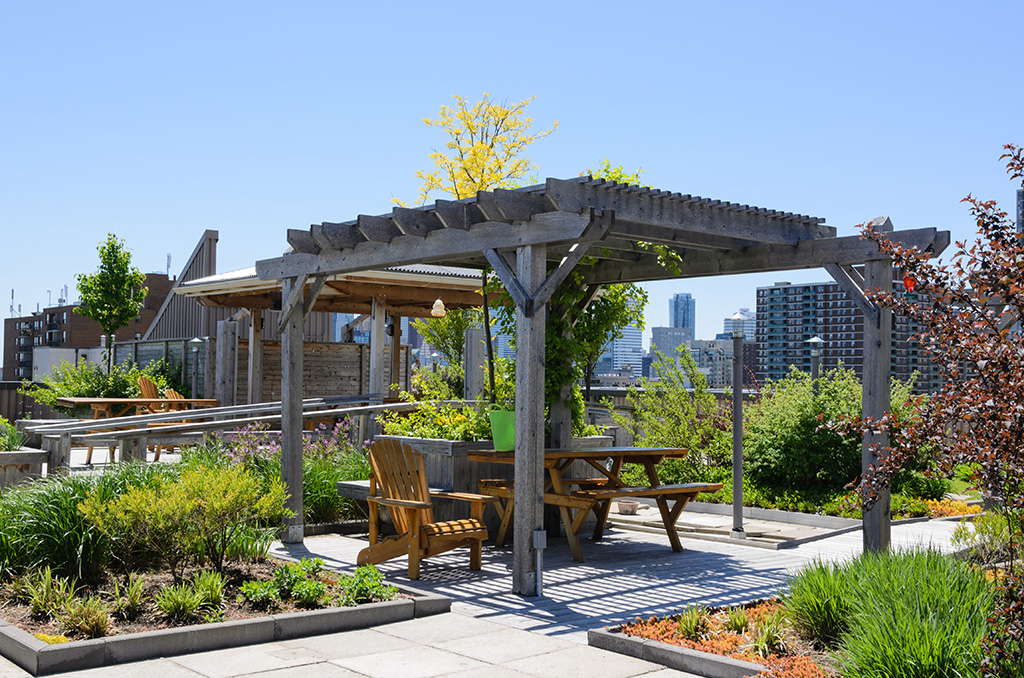
- Intensive: Intensive green roofs are the most common type of green roofs on commercial buildings. You can walk on them, garden on them, and even put entertainment spaces on them. People stand on these roofs, so, for safety, they must be installed on flat roofs with a pitch less than 2:12.
In order to accommodate plants that need a lot of room for their roots, such as trees or shrubs, intensive green roofs are deeper. However, this depth also means that an intensive green roof adds a lot of weight to a building, which your architect or structural engineer will need to account for. - Brown Roof: This type of intensive roof is a perfect example of the community benefit a commercial green roof can provide. A brown roof is a type of living roof designed to support biodiversity or solve a specific ecosystem problem. For example, a brown roof may be used to provide habitat or food to a local endangered species. Brown roofs usually utilize local materials, or formerly developed, land.
- Semi-intensive: Semi-intensive roofs are slightly more shallow than intensive roofs. They are between 6 and 10 inches, which allows them to support select bushes and grasses, but not tall shrubs or trees. However, semi-intensive green roofs are more versatile, as you can install them on flat or low-slope roofs with a pitch less than 4:12. These green roofs are usually not designed to be routinely walked on.
- Extensive: Extensive green roofs are the shallowest, at a depth of less than 6 inches. They don’t support plants with in-depth root systems. Instead, they are usually planted with moss or sedums. These roofs are more often chosen as residential green roofs because they can be placed on roofs with high slopes, of up to 12:12.
The Layers of a Green Roof
Regardless of the type of green roof your company chooses, the layers the roof will require are the same. From bottom to top, here are the layers of a green roof.
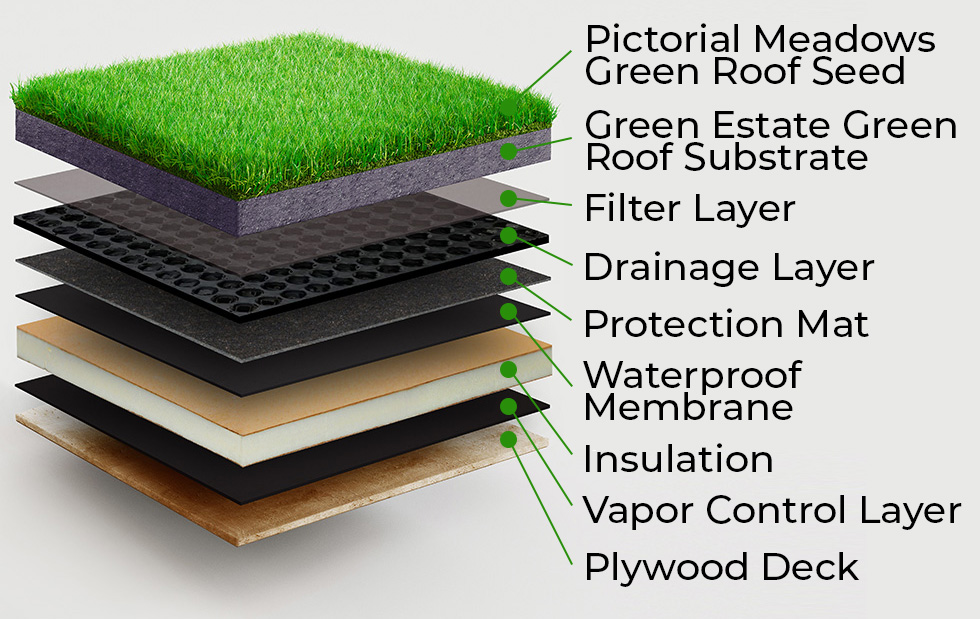
- Sheet metal substrate/decking: Decking is the very base of the roof, the corrugated metal sheets or wooden plywood that everything else is placed onto. Decking is supported by the roof’s rafters and beams.
- Vapour control barrier: A vapour control barrier stops moisture from moving from the living roof into the building or vice versa. It protects the other layers of the roof from developing moisture or rot problems.
- Insulation: Insulation is necessary for any flat roof, but is especially key for a green roof. Many building owners who invest in green roofs are looking to improve energy efficiency and quality insulation is key to doing so. You may use polyiso insulation for this purpose.
- Waterproof membrane: This is the last layer of a green roof system that’s also part of other flat roof systems. The waterproof membrane could be a modified bitumen membrane such as IKO’s Armourplast TM Classic.
- Root barrier: A root barrier protects the rest of the roof from the plants’ roots. Many plants have very aggressive roots that would damage the rest of the roof components if they were not held in check by the roof barrier.
- Drainage layer: Again depending on the kind of substrate material used, an intensive green roof may need a drainage layer. This allows water to leave the living roof in the event of heavy rain. Otherwise, water would soak into the substrate and drown the plants, or add too much weight to the roof.
- Filter layer: Depending on the kind of substrate used in an intensive green roof, it may need a filter layer. This fine netting will keep small particles of substrate from blowing away.
- Substrate/soil: A substrate is a kind of lightweight soil that supports the plant’s roots. Generally, intensive roofs are too heavy if they are composed of real soil. Therefore, lighter, even porous materials are used to house the roots.
- Plants: Plants make up the top layer of the green roof system. On an intensive green roof, you can plant almost any plant you like, with the exception of plants with very aggressive roots, such as bamboo. We go into greater depth on green roof plants below.
Application Systems for Green Roofs
You will also have to choose how your green roof is installed onto your building. The top two layers of the vegetated roof, the plants and substrate, can be installed together or separately.
- Vegetated mats: If you’ve seen a roll of sod laid out on a front lawn, you can picture what a vegetated mat looks like. For this installation method, the plants are grown in the substrate on the ground by the green roof installer. When they are mature enough for transplant, the plants and substrate are cut into mats and then laid on top of the roof.
- Pre-vegetated trays: Certain substrates are made of small grains that can’t be rolled up into mat form. These substrates are placed into plastic trays and the vegetation is planted into them. When the plants are mature, the trays are directly installed onto the roof. The manufacturers of these trays usually provide fasteners to keep the trays on the roof.
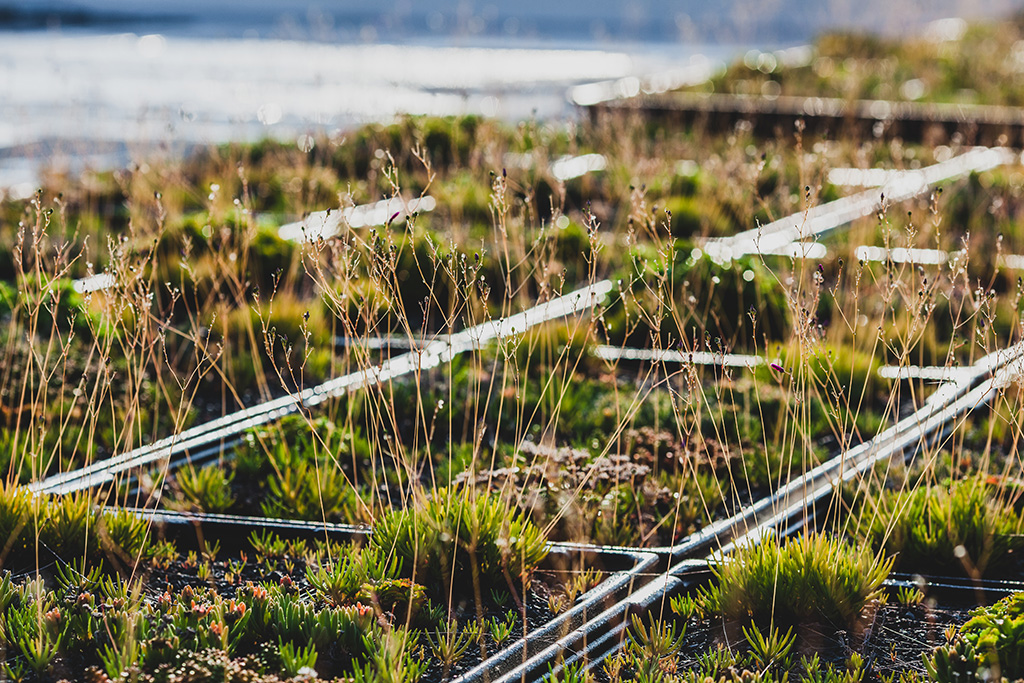
- Plug installation: You may also install the substrate and plants of a green roof separately. After the substrate is raked out onto the roof, you can plant vegetation just as you would in a background garden. Stand-alone plants that are mature or semi-mature and intended for living roofs are called plugs. If you’re installing sedum or mosses, then you may use cuttings instead. These are chopped up bits of plant from which full plants will grow. Cuttings are the moss world’s equivalent to seeds.
- Naturalized green roofs: Sometimes green roofs are left with bare substrate material so that the natural plants of the area will colonize it. This doesn’t take very long. However, you are likely to get weed species if you allow a green roof to naturalize. Those who wish to grow native plants on their green roof may prefer to plant their seeds instead of waiting for nature to populate the roof.
Irrigation Systems for Green Roofs
Where you have plants you will need water. An intensive green roof system that is supporting a lot of plant life will have higher water needs than most. You have a few options to choose from to deliver the water you need to keep your roof healthy.
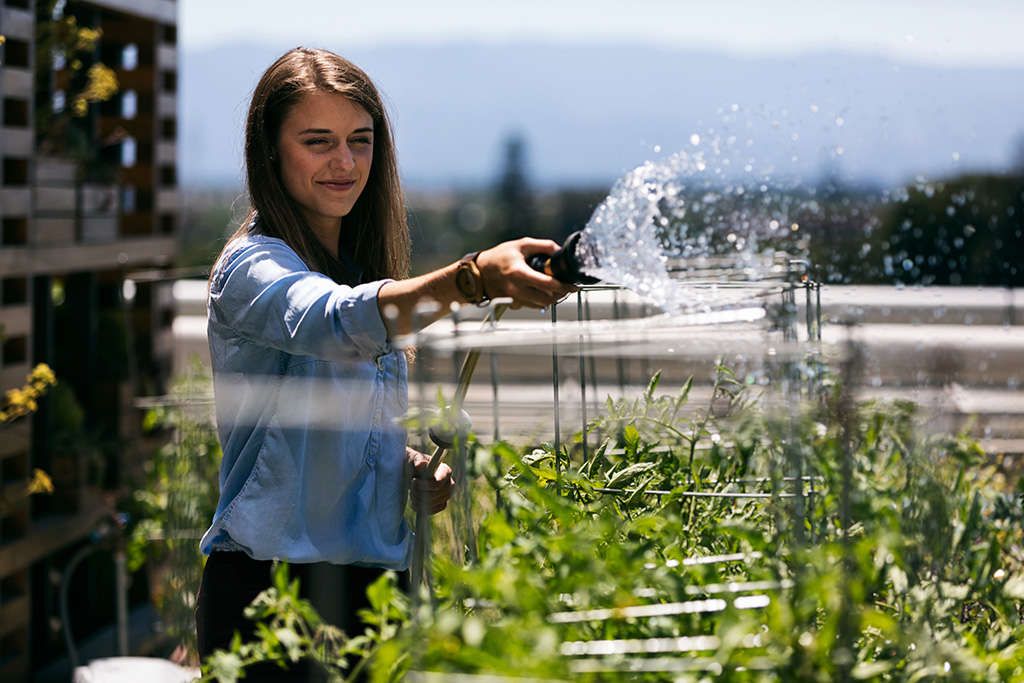
- Spray irrigation: Spray irrigation is the typical watering method you’ll find on front lawns everywhere. A series of sprinkler heads spray water on a regular schedule. You can have smaller sprays called “micro-sprays” that deliver water more consistently and with less evaporation, but wind can blow the spray away more easily.
- Drip irrigation: Drip irrigation delivers water slowly and consistently by dripping at several points along the roof. It can target large plants that might require more water, such as trees or vegetable plots. The system can be set up to deliver water from above or from inside the substrate or drainage layer.
- Drainage layer irrigation: It is possible to flood the drainage layer or the substrate with water from the inside. This can minimize water evaporation and save on water costs. However, it’s harder to target any specific area that might have higher water requirements. Further, it’s more challenging to get the water to the top of the substrate layer, where the plants need it the most.
Both spray and drip irrigation systems can have features installed to help water large roof spaces. Moisture sensors can prevent the system from watering when it is raining. They can also be set to schedules, so that you don’t have to turn them on manually.
Soils for Green Roofs
There are many different substrate materials available for green roof systems. Many are proprietary and only offered from specific manufacturers. However, the substrate mixtures may include these materials:
- Mulch
- Clay
- Peat moss
- Pumice
- Perlite
- Vermiculite
- Soil
- Sand
If you need guidance on what growing material to choose, you can discuss your specific plant’s needs with an experienced green roofing professional, or you can refer to ASTM E2777, the Standard Guide for Vegetative Roof Systems.
Plants for Green Roofs
While most semi-intensive and extensive green roofs systems are planted with short plants such as mosses or sedum, you have many more options when you have an intensive roof. They can support almost anything from grasses to small trees species.
- Native plants: One common choice is to plant your local area’s native species on your green roof. You could have thousands of native species that you can choose from. For example, the Vancouver Convention Center has over 400,000 native plant and grass species. The benefit of choosing native plants is that your roof supplies habitats and food for bugs and other wildlife, supporting your area’s biodiversity.
- Productive plants: Almost anything that you can grow in a garden or farm in your area can be grown on an intensive green roof. The only restrictions are very tall plants that need significant soil room, and plants with very aggressive root systems. You also need to consider that few substrate materials provide the nutrients that “heavy feeder” plants such as grains or tomatoes require. Instead, those nutrients have to be diluted into your water and delivered to the plants.
- Landscaping plants: If your green roof serves more of a park function than a garden function, you can choose landscaping plants to install instead. A local landscaper can tell you which plants are low-maintenance and suitable for your area.
Structural Requirements for Living Roofs
Supporting these plants, soil, and other layers of a living roof is a big job. Any structure that is to be built with a green roof or retrofitted with a green roof needs to be structurally prepared to handle a heavy load.
Intensive roofs especially add a considerable amount of weight to a building, not just in extra layers and plant material, but also in water. The exact weight will depend on the system and materials you choose, but it could weigh anywhere from 50 to 500 pounds per square foot. You also have to consider the weight of the maximum number of people that could be on the roof.
The wide variance in weight of a commercial green roof system makes it necessary to choose a specific roof and other materials before construction begins on the building. If you’re retrofitting an existing building, your architect or structural engineer may design changes you need to implement in order for the building to support the green roof system. The extent of these changes depends on the existing building and the system you want to implement. It could be simple, or very expensive.
Benefits of Commercial Green Roofs
All of these layers, requirements and complexities make green roofs astounding systems. They provide benefits not just to your property and your business, but to the community and city as a whole. Here are the major advantages a green roof can offer you:
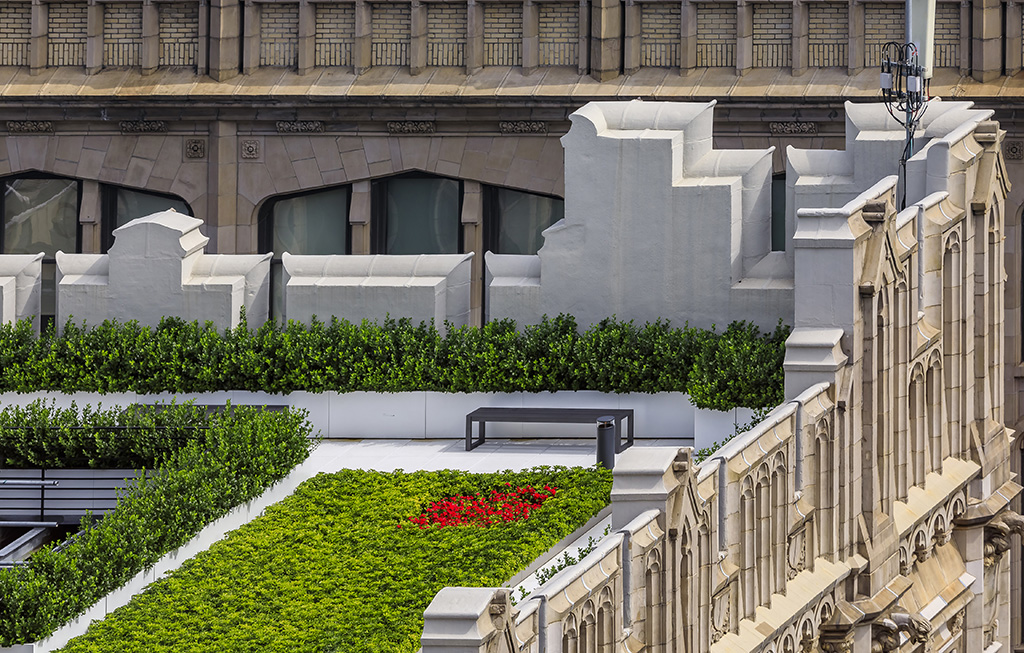
- Beauty: The first advantage of an eco-roof is its beauty. Intensive green roofs especially can support any number of beautiful plants and provide a green space for building occupants to enjoy or garden in. For example, the NYC Parks Department has invested in green roofs as a way to expand the green spaces available in the city.
- Heating and cooling costs: Eco-roofs provide excellent insulation and can stabilize the temperature in the building below. They absorb ultraviolet (UV) radiation, reducing the heat in the building below. In the winter, the plants maintain heat instead to potentially reduce heating costs.
- Longer membrane life: The same UV absorbing properties that make living roofs excellent insulators also help the modified bitumen membranes installed beneath them. In their Green Roof Systems Manual from 2007, the National Roofing Contractors Association (NRCA) stated that green roofs reduce the wear roofing membranes experience from UV radiation, increasing their service life.
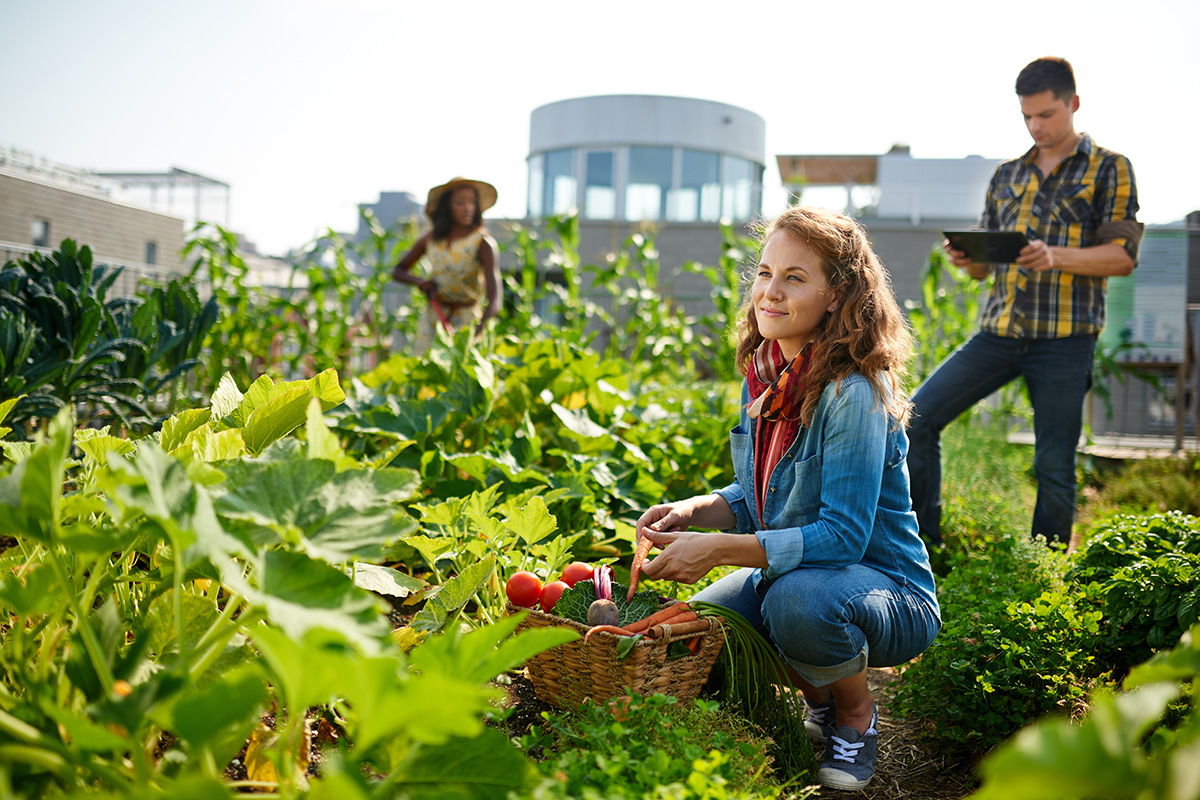
- Selling point: Occupants and building users may be drawn to a building with a green roof because it’s beautiful and provides them with green space. This can attract residents and customers to apartment buildings, office spaces, or entertainment-based businesses. For example, a green roof was installed on the Vancouver Convention Center.
- Research possibilities: Universities and other research facilities can use green roof systems to explore unique research opportunities and attract life sciences or landscaping students and researchers. Many universities have invested in eco-roofs, including Michigan State.
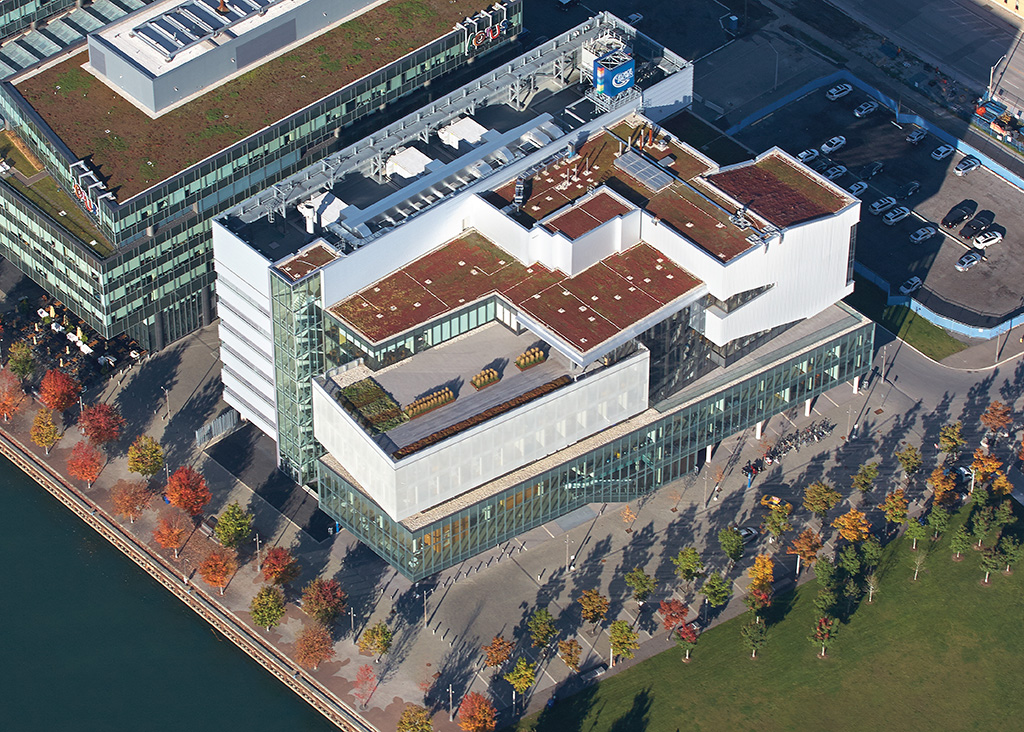
- Stormwater management: The large plant matter on intensive green roofs absorbs a significant amount of water when it rains. Green roofs can help buildings and cities manage stormwater.
- Plant production: Businesses that are already involved in producing plants may find green roofs to be a unique opportunity to grow them, especially in urban areas. Uncommon Ground runs a rooftop garden in Chicago that supplies local restaurants with produce.
- Solar panels: Combining eco-roofs with solar panels can bring in added benefits. Solar panels can further reduce the costs of running your building by supplementing your electricity use, or even replacing it.
- Property value: A building with a green roof can be seen as an asset by potential buyers for all of the above advantages it offers.
- Urban heat islands: All of the asphalt we use on rooftops and roads absorbs and radiates heat, increasing a city’s temperature by a few degrees. This is called the Urban Heat Island Effect. Researchers have found that green roofs reduce this effect and thereby increase comfort and lower cooling costs for cities in the summer.
- Biodiversity: Green roofs can be designed to provide shelter and food to local insects and animals, increasing the biodiversity of the area.
Disadvantages of Commercial Green Roofs
Vegetated roofs provide a lot of benefits, but they do so at a large cost. Below are the primary disadvantages of vegetated roofs:
- Installation costs: The initial costs of installing a living roof are high. A green roof needs everything that a typical commercial flat roof needs plus all of the layers to support the plants.
- Maintenance: Green roofs also require maintenance. They need to be watered, the plants need to be trimmed or mowed. You may also need to replace dead plants or maintain the irrigation system. You can expect the costs to maintain a green roof to be at least as much as it would cost to maintain a lawn or garden of the same size.
Cost-Benefit Analysis for Green Roofs
It’s difficult to predict the precise costs of a green roof. While your green roof manufacturer should be able to supply you with a cost for installation per foot, you also have to consider the costs of any structural changes that need to be made to the building to support the roof. Then, there are yearly maintenance costs. You can predict those with some degree of accuracy based on the plants you choose, with some help from a landscaper or an experienced green roof professional.
Once you have your total costs estimated, you need to compare that to the advantages you’re seeking with the green roof. You may be able to estimate how well the roof can reduce your heating and cooling costs, or how many plants you should be able to yield per square foot of your roof. If you’re using your green roof to attract tenants or customers, you should determine whether the presence of a green roof will allow you to command an increased rent or ticket price.
Other benefits may be harder to quantify. Attracting researchers, gaining LEED certification, or building your company’s reputation as an environmentalism-focused business will all affect your bottom line. Ultimately, the number you place on these benefits will be very specific to your company’s circumstances.
Where to Get Started with Green Roofs
If you decide a green roof is a good investment for you, where do you start? Getting in contact with an experienced green roofing professional, who focuses on large, intensive living roofs, is a good start. You can find contractors through IKO’s Contractor Locator tool. You’ll also need to reach out to architects, structural engineers, and landscapers to develop a full plan for your building and its green roof.
